
On our first full day in DC, we visited the National Museum of African American History and Culture. During our walk around the museum, a quotation on a glass case caught my eye, as did the pounds of sugar filling the case. Sitting on top of the sugar was a large and heavy-looking iron bowl. The first part of the quotation was poetic: “Sugar—sweeter, more powerful, and more deadly than gold. Unlike gold, sugar could be grown; it provided the possibility of unlimited wealth.” I was taken aback. I had never thought about the idea that if you have a certain amount of money you just have a fixed amount of money, but if you have sugar or another similar resource, you have a continuing source of money. Slave owners wanted human labor to maintain their sugarcane crops and their continual source of profit. The more sugar you could grow, the more slaves you needed to grow and harvest that sugar, and the more profit you could make. It was a continual cycle: more money, more sugar, more people needed to maintain that sugar, more money, more sugar, more people, etc.
The second part of the quotation on the glass case was a statement of fact: “Life expectancy for an enslaved worker on early sugar plantations was seven years. Mortality rates were thirty percent. The amount of the world’s sugar produced by enslaved Americans in 1787 was ninety percent.” It’s hard to imagine these percentages in real, human terms: out of every ten enslaved Americans, three were murdered. This relatively small exhibit made me think deeply about things that I had not thought about before, and I greatly appreciated the experience. What you learn can stick with you and even change you. This experience has changed me, and I think it will always stick with me.

Today we visited the National Museum of African American History and Culture. All the exhibits were extremely interesting, and it is almost impossible to see everything the museum has to offer in one day. For example, I didn’t get to see the music exhibits, which I think I would have found most interesting. Cooper told me that he saw Chuck Berry’s red Cadillac and some of his musical instruments. Jimi Hendrix’s personal items, such as his jacket and one of his amps, were also on display. I’ll need to go back to the museum one day to see the rest of it, especially the musical exhibits.
My favorite exhibit was in the visual arts area of the museum. I especially liked a quilt hanging on a wall like a tapestry. It had the image of Harriet Tubman in a flowing dress, sitting on a wooden chair. What was most interesting was the appearance of her clothes. The bottom of her dress appeared to be woven from a colorful, flowery landscape: there were many vibrant purple flowers, surrounded by many colors. Each section of the dress contained different types of flowers and other colorful items. There were playful birds on the sleeves, and at the bottom of the dress was a lion staring at the viewer. When I first looked at the quilt, I didn’t catch all the detail, but as I looked closer I noticed what seemed like miniature worlds embedded in the fabric. I liked how the artist used red and blue to represent light and shadow on her face and hands, which I thought was a creative way to give the piece depth and dimension. It was quilted together, and the colors were vibrant. To appreciate a work of art fully, one needs to experience it in person and not simply view it in a book or on the internet. The experience just isn’t the same. I was able to discern subtle textures and differences in color. I think that the piece had a deeper meaning that I couldn’t fully comprehend in one viewing. If I ever return to DC, I definitely want to view it again.

Today we took the African American History tour and visited many memorials and monuments related to African American history. I particularly liked the African American Civil War Memorial. The memorial includes a statue with a different depiction of African American history on each side of it. On one side is a depiction of three soldiers engaged in battle, and on the other side is a depiction of a family. Dre’, our tour guide, explained to us that the side with the soldiers represents the reality of the war, while the side with the family represents the humanity for which they were fighting. After reflecting on the memorial and discussing it with my peers, I came to realize what the memorial means to me. I see it as representing different kinds of fighting or struggling. The military arms that the soldiers carry represent overt physical fighting or struggle, while the family represents a more abstract and emotional kind of struggle, the struggle for human rights as an African American.
The memorial features a quotation from Frederick Douglass that expresses this idea of struggle: “Who would be free themselves must strike the blow. Better even die than to live slaves.” Tens of thousands of African Americans fought in the war for the chance to escape slavery. They fought for their own freedom and the freedom of others, and in doing so they risked and in many cases sacrificed their lives. I had already learned about slavery in US History class, but this quotation deepened my understanding of the reality of slavery. As a Hispanic woman living in the twenty-first century, I cannot know the reality of slavery firsthand, but today I came to understand better what the experience of slavery meant to those who endured it.
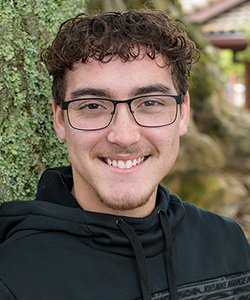
The National Museum Of African American History and Culture preserves and celebrates the rich heritage of African Americans. I was particularly interested to learn about the history of African Americans in the music industry. There were seemingly endless walls celebrating African American artists from genres such as psychedelic funk, R&B, soul, blues, and gospel. Not only did I learn more about artists with whom I was already familiar, but I was introduced to dozens of African American musical artists I had never heard of who had an impact on the music industry and American culture.
I especially liked learning about the impact that these artists had both on the genres in which they performed and on how we think about American society. An exhibit entitled “Revolutions of Sound” depicted how artists such as Prince tackled social issues such as racial segregation, unequal pay, and the discrimination to which black artists have been subjected. The museum did an amazing job of presenting difficult and traumatic aspects of history while displaying the beauty and power of the musical achievements of African American artists. I nearly came to tears while viewing a display of an African American artist singing about inequality, surrounded by black and white people holding each other and crying. I felt the emotion and connection the music brought to the people listening. I am most grateful for the opportunity to visit this magnificent museum, and I hope that next year’s students will experience the same thoughts and emotions I experienced today.

Today was our first day in DC, and we enjoyed sunny weather. The humidity came as a bit of a shock, but it was a good change anyway. The neighborhood we’re staying in this week is gorgeous and looks like something from a fairy tale, with colorful houses, beautiful flowers, and all sorts of green living things everywhere. The Metro is very convenient and a fun way to travel about the city and view it.
The most important part of the day for me was our trip to the National Museum of African American History and Culture. The more I read and saw, the more horrified I became at the history of slavery. Dehumanizing people in any way is disturbing, but learning about the ways in which slave owners did not comprehend the inhumanity of their actions was particularly disturbing. This part of American history should be discussed more, to acknowledge the inhumanity and cruelty of slavery and to honor the lives of those who were enslaved. The exhibit in the museum that most affected me was a drawing of slaves being transported in ships across the Atlantic. The drawing showed human beings herded together like animals and stacked on one another like lumber. Words only begin to express the horror depicted in the drawing. Standing before such a graphic representation of such an abominable part of US history deepened the understanding of it that I gained from US History class and deepened my empathy for those Americans whose lives were a part of this terrible part of US history.

During our African American History tour today, our tour guide, Dre’, asked us, “What did the Emancipation Proclamation do?” When I thought about what my response would be, I acknowledged that the first answer that came to my mind was the one people typically believe: “Got rid of slavery?” Dre’s eyes narrowed when someone yelled out that answer, indicating that it wasn’t the answer he wanted to hear. Someone gave a more specific answer: “It declared that all persons held as slaves within the rebellious states “henceforward shall be free.” Dre nodded his head a little, but he was still unsatisfied. I thought more about his question, and I began to realize that the answer was something that many in my country don’t know. Dre’ explained that the Emancipation Proclamation was limited in many ways. First, it only applied to states that had seceded from the Union, which meant that slavery remained accepted in the loyal border states. Secondly, the Proclamation exempted Confederate states that were under Union control. Therefore, slavery wasn’t abolished nationwide. So what exactly did the Emancipation Proclamation do? Absolutely nothing.
We then visited the National Museum of African American History and Culture. Anya and I explored the museum together, and we began our visit on the bottom floor, in the “History Gallery.” As we waited in line, a staff member said to us, “If you guys get scared, don’t complain to me, because I am about to clock out and don’t want to deal with that right now.” I laughed, but it was daunting to learn that the gallery I was about to enter upset people that much. The gallery recounted events from the start of the Transatlantic Slave Trade to the late-1870’s and the failure of Reconstruction. The portion of the exhibit that affected me most was a long, dark room that showed what life was like for those who were transported across the Atlantic. I learned that when the Spaniards transported slaves, they wouldn’t stick their heads in the cargo holds of the ship because the smell was unbearable. I also learned that by the time a ship arrived at its destination, the majority of those being transported had died. I turned to face a pair of shackles. A couple standing next to me held their arms next to the shackles to see which ones would fit their wrists. At first I was disgusted. I then thought that perhaps they didn’t fully understand the reality of this historical event. Then I came to another idea: perhaps they were trying to experience some of that reality for themselves. When we learn about history it often doesn’t seem real, due to a lack of lived experience.
I’ve always thought that learning about slavery is horrifying, but my experience today in the museum was gut wrenching, knowing that people are capable of exploiting others without consequence or remorse.

On the morning of our first full day in DC, we were fortunate to visit the Dr. Martin Luther King Jr. Memorial as part of the African-American history tour. I was particularly excited about visiting this memorial because during our Values class this semester I wrote about it as part of an assignment to research memorials and monuments in DC. The experience of viewing the memorial in person was surreal, as I came to the realization that I was actually standing in Washington, DC, gazing at the granite image of Dr. Martin Luther King, Jr. Around me, people were taking photos and surveying the memorial solemnly. I felt a sense of community with those around me who share my appreciation of the work and ideas of MLK. The memorial made this connection with others tangible, despite differences in age, gender, race, and geography.
Walking along the wall of engraved quotations from MLK, I came across one quotation that deeply affected me: “We must come to see that the end we seek is a society at peace with itself, a society that can live with its conscience.” I grasped its significance more fully when I viewed the historical section of the National Museum of African American History and Culture. I realized that the museum represents both our country’s successes and its failures at “living with its conscience.” I think that our class began a process of learning about some of our country’s disappointments and cleansing ourselves of the delusion of American perfection that we are often expected to believe.
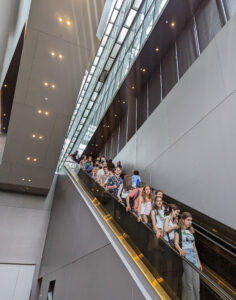
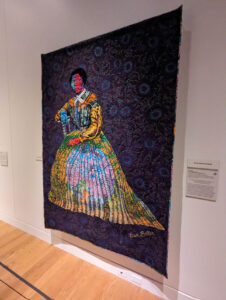
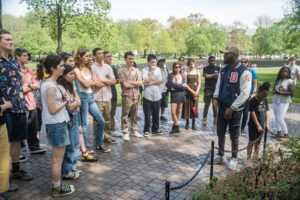
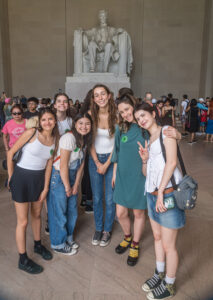
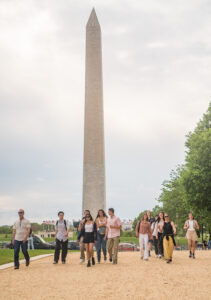
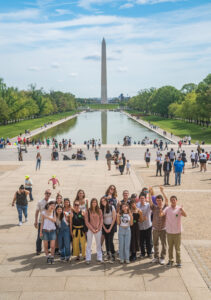
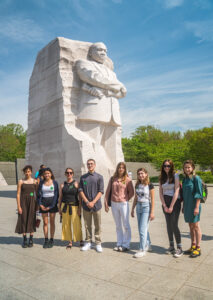
You must be logged in to post a comment.